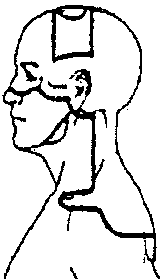Figure 5
Segmentally related referred pain patterns observed over the years by a number of independent investigators immediately after the experimental noxious stimulation of purely somatic paraspinal structures.
The illustrations shown below are composite representations of results obtained by:
A. Campbell and Parsons [71],
B. Dwyer et at. [83],
C. Feinstein et at. [76],
D. Kellgren [66],
E. McCall et al. [79], and
F. McCall et at. [79].
Interestingly, the intensity, distribution and affective characteristics of the pain perceptions induced in these normal experimental subjects were often found to be astonishingly similar to those typically exhibited by patients known to be suffering from a variety of primary internal organ diseases or conditions. The diffuse pain referral patterns elicited in these subjects were also often accompanied by a number of additional secondary regional and/or global reflex based signs and symptoms that were also virtually identical to (and therefore easily mistaken for) those commonly observed in patients harboring true primary visceral disease (see Figure 4). Over the last fifty years, a tremendous amount of both experimental and clinical information has accumulated in the scientific literature concerning somatic pain syndromes and the basic neuronal mechanisms that may often conspire to create overt patterns of signs and symptoms that mimic, or simulate, those classically associated with a number of regionally related primary visceral disorders (see Table 1).

|
Fig. A-1
Occiput to C2
|

|
Fig. A-2
C3 to C5
|
|
|

|
Fig. B
C2 through C7
|
|
|
|

|
Fig. C
C1 through L1
|
|
|
|

|
Fig. D-1
T2 through L2
|

|
Fig. D-2
T2 through L2
|
|
|
|

|
Fig. E-1
L1 through L5
|

|
Fig. E-2
L1 through L5
|
|
|
|

|
Fig. F-1
L1 through L5
|

|
Fig. F-2
L1 through L5
|